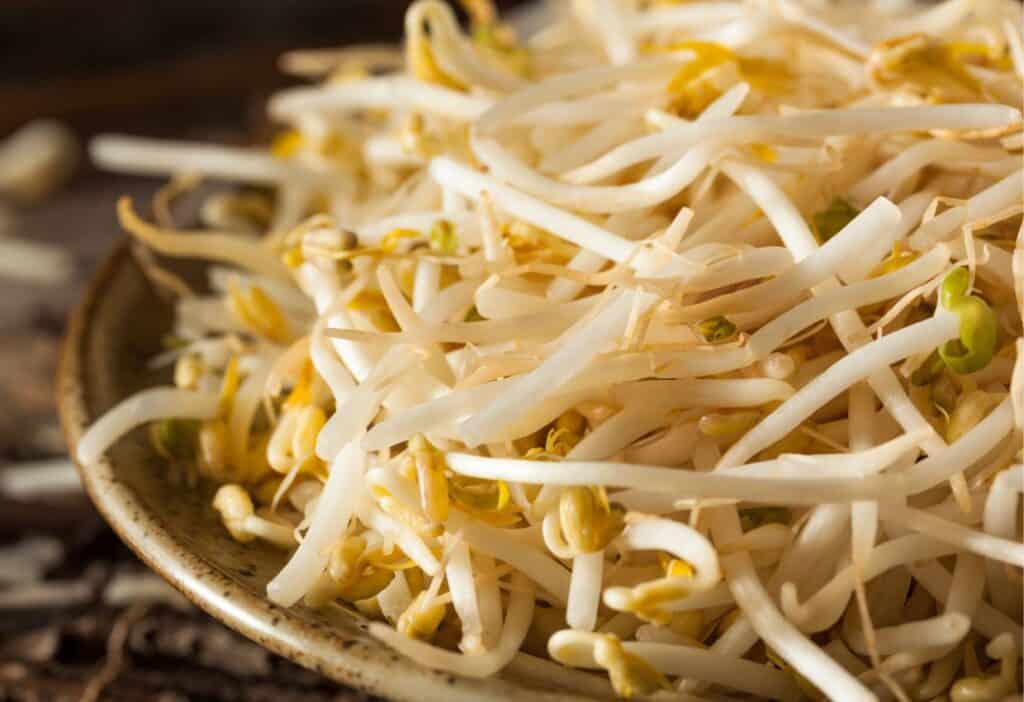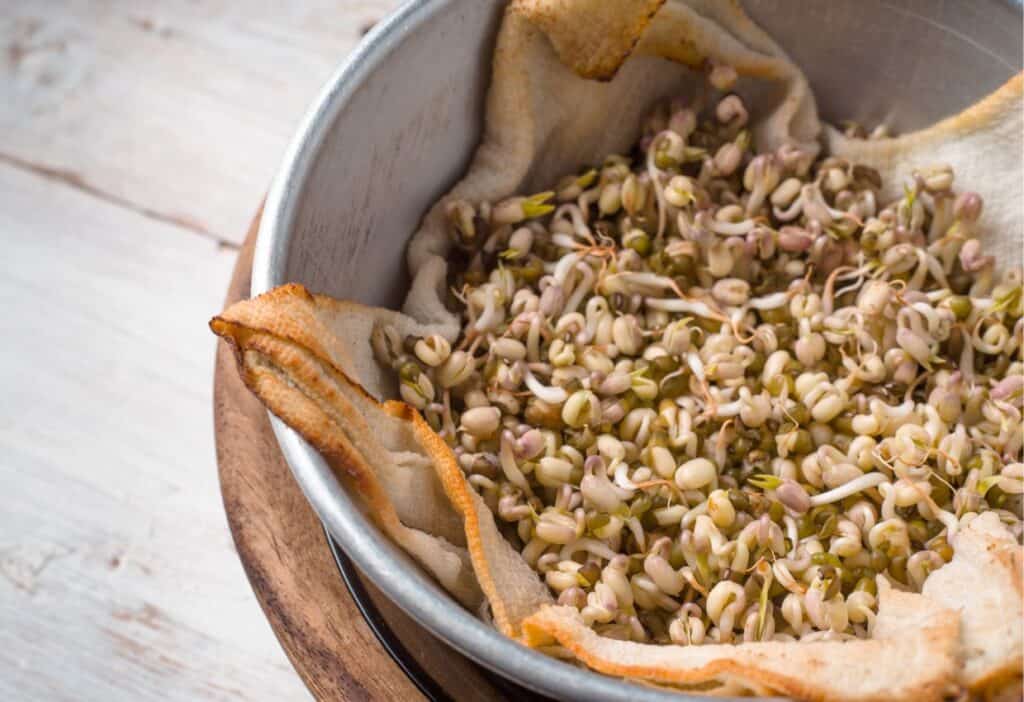Dive into the world of mung bean sprouts, a nutrient-packed superfood. Learn about their health benefits, culinary uses and how to grow them at home in this comprehensive guide.

These statements have not been evaluated by the Food and Drug Administration. Please see the disclaimer below for more information.
Understanding the nuances of sprout cultivation and the best practices for cooking with mung bean sprouts can transform them from a mere garnish to a centerpiece in plant-based cuisine. They add not just a textural contrast but also enhance the overall experience of a dish with their health benefits. This makes them a versatile addition to any meal, appreciated for their ability to complement a wide range of ingredients and provide a burst of freshness and nutrition.
Essentials of mung bean sprouting
Select high-quality beans and follow proper sprouting techniques to ensure successful mung bean sprout growth. Harvest the sprouts when they reach the desired length and enjoy their crisp, fresh flavor in salads, stir-fries or as a nutritious garnish.
Selecting quality mung beans
Choose whole, untreated mung beans, as these are optimal for sprouting. Beans should be free from cracks or damage. Refrain from using beans packaged for gardening, as they may contain chemical treatments.
Preparation for sprouting
Before sprouting, thoroughly rinse the mung beans in cool water to remove debris. Soak the beans in a large container or a mason jar with sufficient water, allowing space for expansion. Soak the beans overnight or for at least 8 hours.
Sprouting techniques
Transfer the soaked beans to a sprouting jar or a colander lined with cheesecloth. Ensure the container has a mesh lid or cheesecloth cover to facilitate airflow while keeping contaminants out. Store the container in a dark place and rinse the beans daily to prevent mold growth.
Harvesting sprouts
Once the beans have sprouted to the desired length, typically after 2 to 5 days, expose them to bright light to enhance chlorophyll production. After rinsing one final time, the sprouts are ready to be consumed or stored in your refrigerator.

The nutritional profile of mung bean sprouts
Mung bean sprouts are a highly nutritious addition to any diet, boasting a rich array of micro-nutrients and associated health benefits. They are particularly noted for their high protein and fiber content, as well as being an excellent source of vitamins and minerals.
Packed with vitamin C, folate, and antioxidants, mung bean sprouts are undoubtedly healthy, according to the USDA. Adding just a serving to your meals boosts your protein intake for muscle growth, fiber for digestion, vitamin C for immunity and skin health and folate for cell development. Beyond these, sprouts also deliver essential minerals like magnesium and phosphorus, supporting bone health and energy levels. Mung bean sprouts truly offer a nutritional punch vital for a well-rounded diet.
“Mung bean sprouts add a nice, crunchy texture and a slightly sweet flavor when added to salads or tossed into stir-fries and soups at the last minute. At home in India, my mom would sometimes add sprouted mung beans to make street snacks called “chaat” to add some nutrients to a fun snack.”
— Shruthi Baskaran-Makanju, Urban Farmie
Eating mung bean sprouts
Mung bean sprouts are a nutritious addition to meals, offering a crunchy texture and a mild flavor that can enhance various dishes. They are simple to prepare, and you can add them to a wide range of recipes.
Salads and stir-fries
Mung bean sprouts can bring a refreshing crunch to salads. They work well with leafy greens, sliced vegetables and a light vinaigrette to create a healthy, fiber-rich meal. For stir-fries, adding sprouts towards the end of cooking preserves their texture and nutritional value. They pair well with strips of bell peppers, onions and proteins like tofu or chicken, all quickly sautéed with a splash of soy sauce over steamed rice.
Asian cuisine
Incorporating mung bean sprouts into your diet is an excellent way to delve into Asian cuisine. Toss them into a steaming bowl of pho to add texture, or mix them with noodles and a savory sauce for a quick pad Thai. Traditional dishes like “chaat,” an Indian savory snack, and “pani puri,” another common Indian street food, also benefit from the sprouts’ crispness. If you are curious about the different types of sprouts used in these dishes, exploring their unique flavors can expand your culinary repertoire.
“I love that mung bean sprouts are a quick and easy way to add some extra nutrition to my meals, as they are high in fiber, protein and other nutrients, including vitamins A, B1, B2, C, E, potassium, phosphorus and iron. And since they are sprouted, that makes them easier to digest, too. I typically add them to sandwiches, salads or wraps for a nice crunch, or toss a handful into a stir fry right before serving.”
— Anne Mauney, MPH, RD, fANNEtastic food

Storing mung bean sprouts
Proper storage of mung bean sprouts is essential to maintain freshness and reduce the risk of contamination. Specific techniques in refrigeration can substantially impact the quality of these nutritious sprouts.
Storage
To ensure that mung bean sprouts remain crisp and fresh in the refrigerator, store them in a way that balances moisture and air circulation. To store mung bean sprouts in the fridge:
- Wrap sprouts in paper towels. Wrapping them gently in paper towels absorbs excess moisture.
- Use airtight containers. Place the wrapped sprouts in an airtight container to prevent excess air from entering.
By employing these techniques, you can maintain bean sprouts at an ideal temperature and humidity level. This not only promotes their growth but also ensures they stay fresh and safe for consumption.
Preventing contamination
Preventing contamination is critical when handling mung bean sprouts to avoid health risks. Handling bean sprouts with clean hands is imperative to ensure their safety and freshness and minimize the risk of contamination. It’s also crucial to store them separately from raw meat and poultry in the refrigerator to prevent cross-contamination. For those looking to enhance moisture control, opting for clean cotton cloths as an alternative to paper towels can offer additional absorbency, keeping the sprouts in optimal condition. In adopting these practices, the chance of bacterial growth is minimized, providing a safer consumption experience for mung bean sprouts.
Wrapping it up
Embracing mung bean sprouts adds a refreshing crunch to meals. It can enrich your diet with essential nutrients, offering a straightforward path to enhancing overall health and culinary creativity. Whether you’re a seasoned chef or a kitchen novice, this guide provides all you need to confidently grow, cook and enjoy mung bean sprouts, making them an indispensable addition to your cooking repertoire.
These statements have not been evaluated by the Food and Drug Administration. The contents of this article, made available via Food Drink Life, are for informational purposes only and do not constitute medical advice. The content presented here is not intended to be a substitute for professional veterinary advice, diagnosis or treatment. Always seek the advice of a qualified veterinarian with any questions you may have regarding a medical condition or dietary changes. Reliance on any information provided by this article is solely at your own risk.
Kristen Wood is a food writer, photographer, recipe developer and avid sprouter. Her site, The Wonderful World of Sprouts, is the top resource for everything sprouts-related. She is also the author of Vegetarian Family Cookbook, Fermented Hot Sauce Cookbook, and Hot Sauce Cookbook for Beginners. Her work has been featured in various online and print publications, including AP News, Elle, Martha Stewart, Yoga Journal and more.